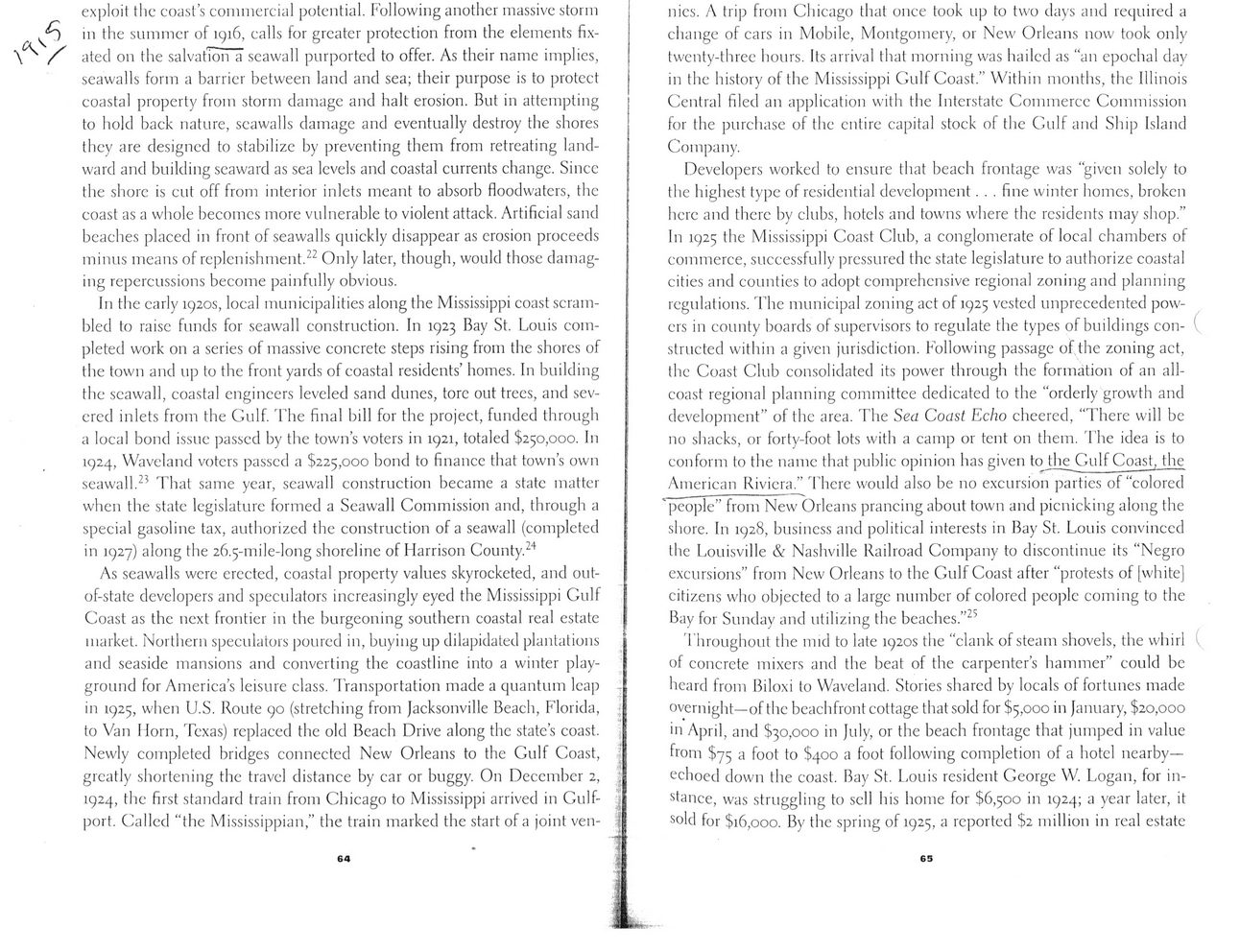This text was obtained via automated optical character recognition.
It has not been edited and may therefore contain several errors.
exploit the coast’s commercial potential. Following another massive storm in the summer of 1916, calls for greater protection from the elements fix-atecl on the salvation a seawall purported to offer. As their name implies, seawalls form a barrier between land and sea; their purpose is to protect coastal property from storm damage and halt erosion. But in attempting to hold back nature, seawalls damage and eventually destroy the shores they are designed to stabilize by preventing them from retreating landward and building seaward as sea levels and coastal currents change. Since the shore is cut off from interior inlets meant to absorb floodwaters, the coast as a whole becomes more vulnerable to violent attack. Artificial sand bcaches placed in front of seawalls quickly disappear as erosion proceeds minus means of replenishment.22 Only later, though, would those damaging repercussions become painfully obvious. In the early 1920s, local municipalities along the Mississippi coast scrambled to raise funds for seawall construction. In 1923 Bay St. Louis completed work on a series of massive concrete steps rising from the shores of the town and up to the front yards of coastal residents’ homes. In building the seawall, coastal engineers leveled sand dunes, tore out trees, and severed inlets from the Gulf. The final bill for the project, funded through a local bond issue passed by the town’s voters in 1921, totaled $250,000. In 1924, Waveland voters passed a $225,000 bond to financc that town’s own seawall.23 That same year, seawall construction became a state matter when the state legislature formed a Seawall Commission and, through a special gasoline tax, authorized the construction of a seawall (completed in 1927) along the 26.5-mile-long shoreline of Harrison County.24 As seawalls were erected, coastal property values skyrocketed, and out-of-state developers and speculators increasingly eyed the Mississippi Gulf Coast as the next frontier in the burgeoning southern coastal real estate market. Northern speculators poured in, buying up dilapidated plantations and seaside mansions and converting the coastline into a winter playground for America’s leisure class. Transportation made a quantum leap in 1925, when U.S. Route 90 (stretching from Jacksonville Beach, Florida, to Van Horn, Texas) replaced the old Beach Drive along the state’s coast. Newly completed bridges connected New Orleans to the Gulf Coast, greatly shortening the travel distance by car or buggy. On December 2, 1924, the first standard train from Chicago to Mississippi arrived in Gulfport. Called “the Mississippian,” the train marked the start of a joint ven- 64 nics. A trip from Chicago that once took up to two days and required a change of cars in Mobile, Montgomery, or New Orleans now took only twenty-three hours. Its arrival that morning was hailed as “an epochal day in the history of the Mississippi Gulf Coast.” Within months, the Illinois Central filed an application with the Interstate Commerce Commission for the purchase of the entire capital stock of the Gulf and Ship Island Company. Developers worked to ensure that beach frontage was “given solely to the highest type of residential development. . . fine winter homes, broken here and there by clubs, hotels and towns where the residents may shop.” In 1925 the Mississippi Coast Club, a conglomerate of local chambers of commerce, successfully pressured the state legislature to authorize coastal cities and counties to adopt comprehensive regional zoning and planning regulations. The municipal zoning act of 1925 vested unprecedented powers in county boards of supervisors to regulate the types of buildings con- ( structed within a given jurisdiction. Following passage of the zoning act, the Coast Club consolidated its power through the formation of an allcoast regional planning committee dedicated to the "orderly growth and development” of the area. The Sea Coast Echo cheered, “There will be no shacks, or forty-foot lots with a camp or tent on them. The idea is to conform to the name that public opinion has given to the Gulf Coast, the American Riviera.” There would also be no excursion parties of “colored people” from New Orleans prancing about town and picnicking along the shore. In 1928, business and political interests in Bay St. Louis convinccd the Louisville & Nashville Railroad Company to discontinue its “Negro excursions” from New Orleans to the Gulf Coast after “protests of [white] citizens who objected to a large number of colored people coming to the Bay for Sunday and utilizing the beaches.”25 Throughout the mid to late 1920s the "clank of steam shovels, the whirl ( of concrete mixers and the beat of the carpenter’s hammer” could be heard from Biloxi to Waveland. Stories shared by locals of fortunes made overnight—of the beachfront cottage that sold for $5,000 in January, $20,000 in April, and $30,000 in July, or the beach frontage that jumped in value from $75 a foot to $400 a foot following completion of a hotel nearby-echoed down the coast. Bay St. Louis resident George W. Logan, for instance, was struggling to sell his home for $6,500 in 1924; a year later, it sold for $16,000. By the spring of 1925, a reported $2 million in real estate 65

Gulfside Methodist Assembly Land-was-Ours---book-Kahrl-(04)